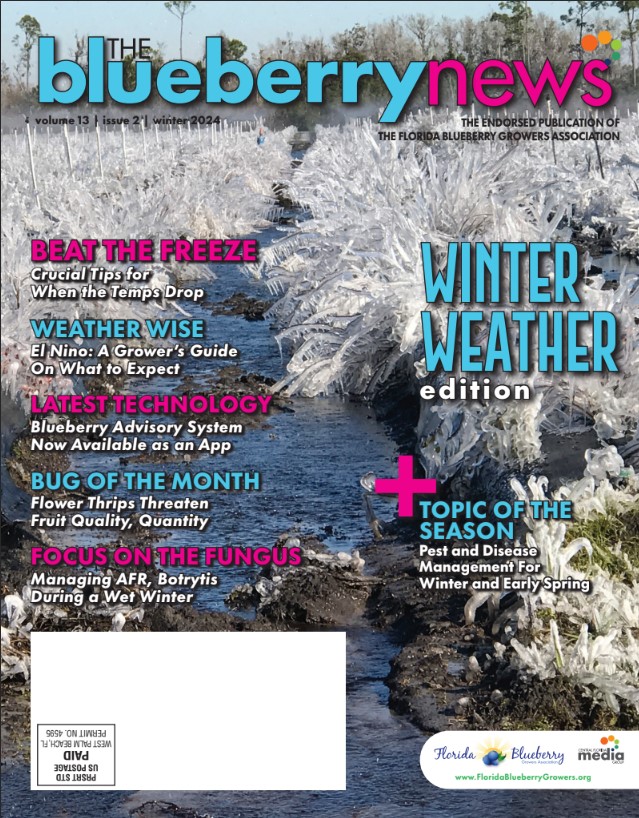Successfully Manage Anthracnose and Botrytis During the Wet Winter Months
With a wet El Niño winter forecasted for Florida in 2024, growers should focus on plans to minimize and manage flower and fruit fungal diseases. Anthracnose fruit rot and Botrytis blossom blight are the most prevalent and significant winter and early spring diseases in Florida.
Anthracnose Fruit Rot
Anthracnose fruit rot (AFR) is caused by the fungus Colletotrichum gloeosporioides. Its development is highly dependent on favorable weather conditions, including extended leaf wetness duration. Symptoms typically begin to appear as berries start to ripen, including the development of sunken lesions, shriveling, and fruit softness, along with the eruption of orange or salmon colored spores. In some cases, symptoms do not appear until after the fruit is harvested and stored. However, infection can occur as early as bloom.
Anthracnose fruit rot sporulation on infected berry.
Credits: A. Gama, UF/IFAS
Fungicide applications from bloom through harvest prevent significant ripe rot losses most years when coupled with frequent hand-harvesting and rapid-cooling practices that are standard for SHB growers in Florida. Pre-harvest fungicides are especially important in years where there is a high incidence of disease in the field coupled with warm, wet weather, which can promote disease development. Many Florida growers use a calendar-based spray program, although the Blueberry Advisory System (now available as a phone app, see article on page 13 of this edition of The Blueberry News) is a tool that will alert growers when there is a higher risk of disease development. Suggested fungicides include azoxystrobin, captan, cyprodinil + fludioxonil, pyraclostrobin + boscalid, fluazinam, and others. However, resistance to QoI fungicides such azoxystrobin and pyraclostrobin has been observed in Florida fields and resistance to boscalid has been observed in the lab.
Botrytis Blossom Blight
Botrytis blossom blight, caused by the fungus Botrytis cinerea, typically infects wounded or senescent plant tissues. As a blueberry bush blooms, corollas (the fused petals of the flowers) senesce and become susceptible to infection. Ideally the corolla should drop from the flower following pollination but before senescence occurs. Frost damage on tender new growth may wound the plant, delay petal drop, and facilitate infection by the Botrytis fungus. After pollination of a flower and drop of the corolla, the risk of infection of the developing fruit is reduced.
The development of Botrytis blight, like many other foliar fungal diseases, is very dependent on environmental conditions. During bloom, periods of low temperatures combined with extended periods of high relative humidity can result in more than 24 hours of leaf wetness, increasing the likelihood of significant disease development. Also, in most years Florida blueberry growers use overhead irrigation for freeze protection during bloom. While sometimes necessary, frequent overhead irrigation at this time of year increases the likelihood of Botrytis blossom blight.
If progress of the blight is suppressed by environmental conditions, a fungicide application, or by plant defenses, disease progress may stop, but the fungus may lie dormant in the immature fruit. If the blight continues an entire cluster of berries can be aborted, and when disease is severe berry reduction can become economically important. Infected berries are sometimes deformed and may develop further rot if environmental conditions later become favorable for disease. This disease is more frequently observed in a post-harvest setting than in the field.
Botrytis symptoms on infected blooms.
Credits: P. Harmon, UF/IFAS
Economic loss due to Botrytis can be minimized by limited use of irrigation for freeze protection and judicious fungicide applications. Fungicide applications prior to, during, or immediately following extended cool wet periods during bloom can limit early infection. Untreated infections during bloom can lead to disease problems throughout the season. If Botrytis does become established at bloom, fungicide applications later in the season may be required to manage spread of the fungus to ripening berries. Applications at this time are less efficient and less effective for managing this disease than those at bloom. Fungicides with efficacy on Botrytis include captan, cyprodinil + fludioxonil, fenhexamid, pyraclostrobin + boscalid, ziram, and others. Resistance to site-specific fungicides is a concern with this pathogen. Resistance management strategies are included on the labels of products containing site-specific fungicides. Fungicides with different modes of action should be rotated to help prevent the development of resistance.
For more information on these diseases see EDIS publications PP337, Anthracnose on Southern Highbush Blueberry (https://edis.ifas.ufl.edu/publication/PP337), PP198, Botrytis Blossom Blight on Southern Highbush Blueberry (https://edis.ifas.ufl.edu/publication/PP119) and HS1156, 2022 Florida Blueberry Integrated Pest Management Guide (https://edis.ifas.ufl.edu/publication/HS380).
CREDIT:
DR. PHIL HARMON, Professor, Plant Pathology, UF/IFAS
& DOUG PHILLIPS, Blueberry Extension Coordinator, UF/IFAS





